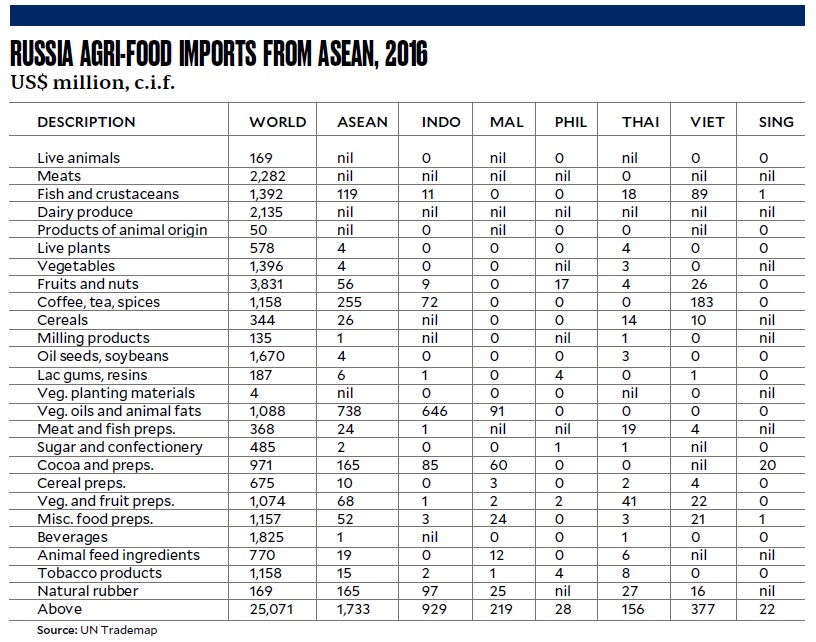
Russia is a major mineral fuel exporter—$135 billion out of $285 billion exports in 2016. Metals also provided another $28 billion. Russia is not just an agri-food exporter (e.g. wheat and seafood), but also a large agri-food importer—$25 billion in 2016. Imports from Asean, however, comprise only seven percent ($1.7 billion). These are dwarfed by imports from the European Union (EU) ($5.6 billion), and the Americas ($6.2 billion) (UN Trademap).
What does Asean sell to Russia? Only four principal products: palm oil from Indonesia and Malaysia; coffee from Vietnam and Indonesia; natural rubber from Indonesia, Thailand and Vietnam; and cocoa products from Malaysia and Singapore. Philippine export is minimal at only $28 million, mainly desiccated coconut, carrageenan and tobacco leaf. Incidentally, the Philippines imported these products valued at $1 billion in 2016. They can be produced in the country!
In a recent Philippine business mission to Moscow, Russia expressed interest to buy $2.5-billion worth of agri-food products from the Philippines over the next 12 months. The numbers need reality checks. They are not credible. Russia is in a diplomatic offensive and wanted to humor the Filipinos. Why? Russia imported only $1.7 billion from the whole Asean and $1.6 billion from China in 2016. And it bought little from the Philippines!
Of Russia’s total banana imports, Ecuador supplied 98 percent, followed by Costa Rica and Mexico. The Philippines supplied 1,700 tons ($1.3 million) out of 1.36 million tons imports ($1 billion). Banana export price from Ecuador is cheaper with bigger fingers, and logistics costs will be challenges.
For comparison, it takes 38 sailing days from Ecuador to St. Petersburg compared to 58 days from Davao to the same port. The distance from Davao to Vladivostok, Far Eastern Province, is 10 days. The Trans-Siberian Railway from Vladivostok to Moscow takes 6.5 days. Fresh bananas may not withstand the handling, and if there is good cold chain at competitive cost during summer and winter.
Expansion of Philippine agri exports would require lots of spade work. The main cities of Russia are located on the west. Of the 12 cities with populations of over one million, ten are in the west, including Moscow and St. Petersburg. The Russian Far East has a population of only 6.5 million, or less than five percent of total population.
In the immediate term, the Philippines needs to mount a market and competitiveness study.
But the greater challenge would be the business climate in the Philippines: Access to land, land leases, and other agribusiness policies. Management expertise and land consolidation are needed to achieve scale in production, agri-processing and exports. The country needs to wake up to global realities. For one, Philippine-based exporters are already tolling in neighboring countries due to shortage of raw materials locally.
Errata. In my column on Asean-Philippines trade, the right figure of Indonesian imports in 2016 should be $70 million, not $7 million. Indonesian exports are lopsided at $700 million. There are non -tariff barriers such as those applied to Philippines bananas.
The article reflects the personal opinion of the author and does not reflect the official stand of the Management Association of the Philippines or MAP. The author is the Vice Chair of the MAP AgriBusiness and Countryside Development Committee, and the Executive Director of the Center for Food and AgriBusiness of the University of Asia & the Pacific. Feedback at <map@map.org.ph> and <rdyster@gmail.com>. For previous articles, please visit

